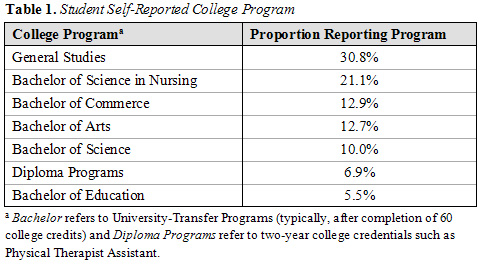
Author
Genevieve M. Johnson, PhD, is with the Department of Psychology at Grant MacEwan College, Edmonton, Alberta. Correspondence regarding this article can be sent to: johnsong@macewan.ca
Abstract: Four hundred five college students completed a questionnaire that assessed patterns of Internet use. Results describe college students, with rare exception, as Internet users. The vast majority of college students frequently communicate online and access websites. While an Internet game experience is typical, relatively few college students are heavy online gamers. Overwhelmingly (i.e., 77.8%), college students conceptualized the Internet as a convenience, although 17.8% considered the Internet a source of amusement. Approximately 5% of college students reported negative perceptions of the Internet (frustrating or a waste of time). Principal component analysis revealed three patterns of online behaviour; integrated-Internet-use, games-only use, and dating-only use. Implications for online instructional practice are presented.
Résumé : Quatre cent cinq étudiants du niveau collégial ont répondu à un questionnaire mesurant leurs tendances de l’utilisation d’Internet. Les résultats présentent ces étudiants comme des usagers d’Internet, à quelques exceptions près. La grande majorité de ces étudiants utilisent fréquemment les outils de communication en ligne et naviguent sur Internet. Alors qu’une expérience de jeu en ligne s’avère commune, peu d’étudiants du collège s’avèrent être des joueurs en ligne excessifs. Essentiellement (c.à-d. 77,8 %), ces étudiants perçoivent Internet comme une commodité, même si 17,8 % d’entre eux le considère comme une source d’amusement. Environ 5 % ont indiqué des perceptions négatives d’Internet (frustrations ou pertes de temps). L’analyse en composantes principales a révélé 3 tendances de comportements en ligne, l’utilisation intégrée d’Internet, l’utilisation seule de jeux et l’utilisation à des fins de rencontre seulement. On présente des conséquences pour la pratique de l’enseignement en ligne.
Online educators necessarily make assumptions about students’ familiarity and comfort with the Internet (Johnson & Johnson, 2006). Reportedly, experience with the Internet mediates student satisfaction with e-learning (Sharpe & Greg, 2005). Rodriquez, Ooms, Montanez, and Yan (2005) surveyed 700 professional and graduate education students and found that comfort with technology was related to satisfaction with online course experience which was related to perceived quality of learning. Johnson and Howell (2005) concluded that “the relative merits of technology become more apparent to students the more technology is used” (p. 651). Seyal, Rahman, and Rahim (2002) demonstrated that Internet experience and perceived usefulness predicted attitude toward Internet technology. Not surprisingly, there is an inverse relationship between Internet experience and Internet anxiety (Chou, 2003; Joiner, Gavin, Duffield, et al., 2005).
Educators are correct in the assumption that post-secondary students are heavier users of the Internet than the general population (Nie, Simpser, Stepanikova, & Zheng, 2005; UCLA World Internet Project, 2004). According to Statistics Canada (2006), 80% of adults with at least some post-secondary education use the Internet, compared with 49% of adults with less education. Jones and Madden (2002) reported that 72% of American college students check their e-mail at least one a day, 85% own their own computers, 60% have downloaded music files, 73% use the Internet more often than the library, 58% have checked course grades online, and 26% instant message daily. Equivalent information on Canadian college students is not readily available.
Instructionally relevant description of Canadian college student Internet use would include demographic information (e.g., percent of the population using e-mail daily) and, perhaps more importantly, analysis of patterns of online behaviour (i.e., characteristic combination of specific Internet applications). Theoretically, patterns of online behaviour may emerge from various combinations of common Internet activities (Johnson, 2006a). Worldwide, e-mail is the single most commonly used Internet application (UCLA World Internet Project, 2004 ). Nie and colleagues (2005) reported that 57% of all Internet use relates to communication (i.e., e-mail, instant messaging, and chat). Accessing websites, although reflecting a wide variety of intentions, is frequently cited as the second most common Internet activity (Internet World Stats, 2006; Statistics Canada, 2006). Finally, approximately one-third of individuals in early adulthood use the Internet to play games (Nie & Erbring, 2002 ; U.S. Census Bureau, 2005). Jones (2003) reported that 70% of college students play video, computer or online games at least once in a while, and 65% are regular or occasional gamers. Patterns of online behaviour may be examined in terms of characteristic use of the Internet to communicate, access websites, and play games (Johnson, in press-a).
Patterns of online behaviour reflect subjective interpretation of Internet applications (Johnson, Howell, & Code, 2005; Shih & Fang, 2004). For example, while elderly Canadians increasingly use the Internet, mistrust of the technology restricts use of applications such as online banking (Fox, 2002; Silver, 2001). Zhang (2002) noted that students differ in their perception of the Internet as enjoyable, useful, or a source of anxiety. Marriott, Marriott, and Selwyn (2004) concluded that college students view the Internet as essentially a social vehicle. Reportedly, 42% of college students use the Internet primarily to communicate socially, 10% use the Internet mainly for entertainment, and 85% consider the Internet a convenience (Jones & Madden, 2002). Such subjective interpretation likely influences the extent to which college student users communicate, access websites, and/or play online games.
The current investigation describes Internet use and patterns of online behaviour among Canadian college students. To what extent and in what ways do college students use the Internet to communicate, access websites, and play games? Does such a trichotomy reveal patterns of online behaviour among college students? What is the relationship between interpretation of Internet and patterns of online behaviour?
Students in an introductory psychology course at a college in western Canada were invited to complete a questionnaire on patterns of Internet use. Course section enrolments ranged from 12 to 60 students, with a total enrolment pool of 528. Primarily due to absenteeism (three students chose not to participate), 405 students satisfied research requirements. Participating students ranged in age from 18 to 44 years (mean 20.8 years). As presented in Table 1, students were registered in a variety of college programs. Students reported an average of 26.9 college credits complete (range 2 to 150). Approximately 72% of the sample was female which is characteristic of the participating college population.

Table 2 presents the proportion of students reporting locations and extent of Internet use. Consistent with findings that the Internet is most frequently used at home (Statistics Canada, 2006), 94.6% of the sample of college students reported frequently accessing the Internet from home. Almost all students reported using the Internet at school; 57.6% of students frequently access the Internet at school. More than 30% of students reported accessing the Internet from a cybercafé; 1% frequently visited cybercafés. Internet access via cybercafés is not an unusual experience for college students but, relative to home and school use, it is rarely a regular location of Internet access.
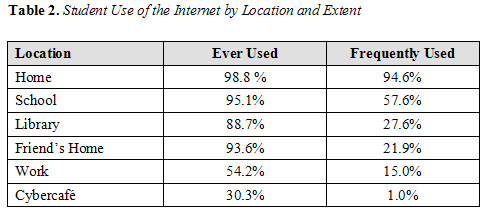
During regular class time, students completed a pencil-and-paper questionnaire that assessed demographic characteristics (described previously) and extent of Internet use. Based on Johnson’s (2006a) trichotomy of Internet activities, five questionnaire rating scale items assessed general Internet use (e.g., I use the Internet to help with school work), five items assessed Internet communication (e.g., I use e-mail), five items assessed website access (e.g., I use search engines), and four items assessed online game playing (e.g., I play strategy games online). Students rated each item on a 5-point Likert scale (i.e., never, rarely, a few times a month, a few times a week, every day or almost every day). One additional questionnaire item determined student subjective interpretation of the Internet; The Internet is (select only one): frustrating, convenient, a waste of time, a source of fun.
Frequency of response-option selection was calculated for each Internet use rating scale item. Cronbach’s alpha coefficients (internal consistency reliability estimates) determined the extent to which Internet use items were accurately organized in terms of communication, websites access, and playing games. Principal component analysis (a variation of factor analysis) identified patterns in students’ ratings of the Internet use items. One-way analysis of variance compared Internet use in relation to college student subjective interpretation of the Internet as frustrating, convenient, a waste of time, or a source of fun.
Table 3 presents the proportion of college students selecting each response-option for the five general Internet use questionnaire items. With respect to the item I am online, only two of the 405 college students surveyed selected the response-option never. Approximately 5% of students indicated infrequent use of the Internet by selecting the response-options rarely or a few times a month. Almost 95% of respondents indicated that they were online at least a few times a week. Communicating and visiting websites represented the most frequent use of the Internet and, while almost two-thirds of respondents had played a game online, only 3.4% of college students reported playing Internet games every day or almost every day. One of the 405 students surveyed reported never using the Internet for help with school work; almost two-thirds used the Internet at least a few times a week for the same purpose. Tabulation of ratings on the five general Internet use items revealed that virtually all college students use the Internet to some extent and that the overwhelming majority are online frequently. Most college students use the Internet to communicate, visit websites, and complete schoolwork; online games are popular with a relative minority of students.
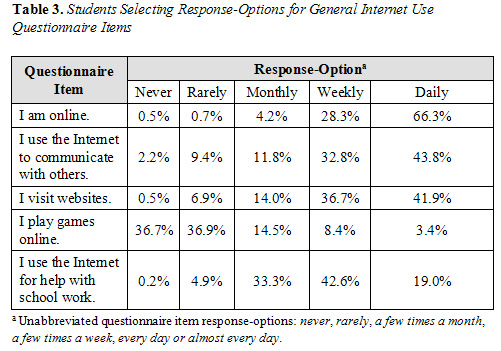
Table 4 presents the proportion of college students selecting each rating-option for the remaining Internet use items organized by activity (i.e., communicating, accessing websites, and playing games). Consistent with reports that e-mail is the most common use of the Internet (e.g., Statistics Canada, 2006), 87.9% of respondents indicated that they used e-mail at least a few times a week. Technically, both chat and instant messaging reflect synchronous communication (Johnson, 2006b). However, chat rooms are typically organized around a common theme or for a particular population while instant messaging is directed toward selected individuals and friends (Joepen, 2005). Instant messaging was far more popular with participating college students than visiting chat rooms. More than one-third of students reported using instant messaging every day or almost every day; 4.9% visit chat rooms with the same frequency. This may reflect college student preference to control the individuals with whom they communicate online (Finn, 2004).

Table 4 also presents the proportion of college students selecting each rating-option for the five questionnaire items that assessed website access. Only two of the 405 college students surveyed reported never using a search engine; 76.6% used search engines at least a few times a week. More than 90% of college students reported downloading or listening to music from the Internet; 27% of the general population has downloaded music from the Internet (Madden & Rainie, 2005). Approximately 90% of respondents accessed personal or private information online (e.g., banking) at least a few times a month. Relative to the general population, college students appear more trusting of Internet security. Fox (2002) noted that “younger Internet users and better-educated Internet users are the most likely to bank online” (p. 1).
Table 4 also presents the proportion of college students selecting each rating-option for the questionnaire items that assessed extent and type of Internet game playing. Sports games appeared the least popular with 82.3% of students never playing such games online. Internet strategy games were the most popular with almost 80% of college students playing such games to some extent. While Geist (1997) suggested that digital games are “changing the way we think, the way we learn, and the way we see the future” (p. 1), a relatively small proportion of college students reported frequently playing Internet games. Indeed, online gaming addiction is typically reported to affect less than 1%, of the college student population, about the same rate as gambling addiction ( Anderson, 2006).
Nunnaly (1978) identified 0.7 as an acceptable reliability coefficient, 0.8 as good, and 0.9 as excellent. The alpha coefficient for student ratings of the five Internet communication items (Table 4) was unacceptable (r = 0.65), suggesting that the items did not measure the proposed category of online behaviour. The alpha coefficient of student ratings of the five website access items was marginally acceptable (r = 0.70) and thus may reflect as a single construct. Student ratings of the four online gaming questionnaire items approximated good internal consistency (r = 0.79); the questionnaire items appear to measure a specific type of online behaviour. In general, however, alpha coefficients do not consistently support the proposed organization of patterns of online behaviour (i.e., characteristic use of the Internet to communicate, access websites, and play games).
Principal component analysis is a statistical technique commonly used to find patterns in complex data (Jolliffe, 2002). A number of correlated variables are reduced to a smaller number of uncorrelated variables referred to as principal components. The first principal component accounts for the most variability in the data and each succeeding component accounts for progressively less of the remaining variability. Within each principal component, positive coefficients reflect increased rating of the item (in this case, rating movement toward 5, everyday or almost everyday) and negative coefficients reflect decreased rating on the item (in this case, rating movement toward 1, never).
The number of principal components necessary to adequately explain a data set is a subjectively determined (Jolliffe, 2002). In the context of the current investigation, because patterns of online behaviour among college students were examined in terms of three common Internet activities (communicating, accessing websites, and playing games), three principal components were used to explain variation in Internet use item ratings. Table 5 presents the coefficients for the three principal components to emerge from 17 Internet use items (two rating scale items, I am online and I use the Internet for help with school work, were deleted from analysis because they did not clearly fit into any of the three categories of common online activities). These three principal components did not correspond to the recently proposed trichotomy of Internet use (Johnson, 2006a).
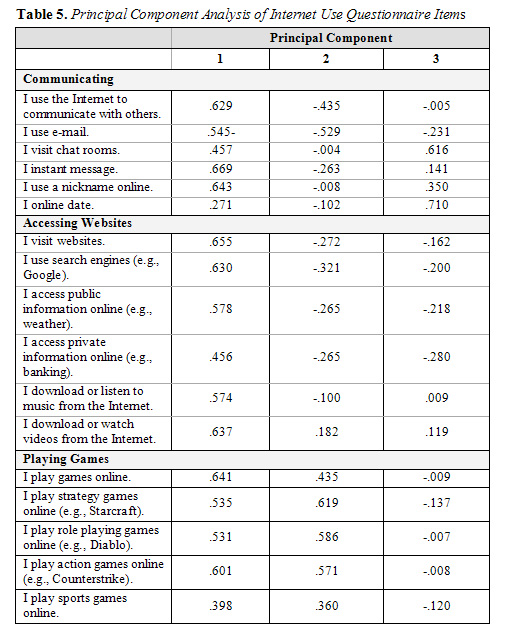
The first principal component loaded positively on all Internet use rating scale items and heavily on most items. The two weakest coefficients were for student rating of the items I online date and I play sports games online. Such a pattern of coefficient strength is interpreted as reflecting a pattern of online behaviour aptly described as integrated-Internet-use (i.e., extensive use of most applications). The second principal component loaded positively and relatively heavily on the online gaming items but negatively and/or marginally on all other items. Such a combination of coefficients is interpreted as reflecting a pattern of online behaviour described as games-only-Internet-use (i.e., limited use of most applications and extensive online gaming). The third principal component loaded positively and heavily on two questionnaire items (I visit chat rooms and I online date) but negligibly on most other uses of the Internet. Such a pattern of coefficients is interpreted as reflecting a pattern of online behaviour described as dating-only-Internet-use, that is, limited use of the Internet except for online dating (dating sites typically include a chat function; MacGowan, 2004). Approximately 53% of the total variance in student ratings of the 17 Internet use items was explained by the three principal components; integrated-Internet-use accounted for 31.3%, games-only-use accounted for 13.7%, and dating-only-use accounted for 7.9%. To summarize, it appears that college students’ online behaviour is not reasonably conceptualized in terms of common online activities such as communicating, accessing websites, and playing games. Furthermore, there are many (more than three) patterns of online behaviour among college students. At the very least, however, online educators may justifiably assume that a significant proportion of college students use the Internet for relatively narrow recreational purposes (i.e., playing games and dating).
Patterns of online behaviour were further explored by the questionnaire item; The Internet is (select only one). Figure 1 provides a visual-graphic summary of the proportion of college students selecting each of the four response-options Five of the 405 college students surveyed (1.2%) expressed the perception that the Internet was a waste of time; 3.2% claimed that the Internet was best described as frustrating. Overwhelmingly (i.e., 77.8%), college students conceptualized the Internet as a convenience, although 17.8% considered the Internet primarily a source of fun. Apparently, most college students consider the Internet a tool that makes their lives easier (i.e., convenience), although a significant proportion defined the Internet as a source of amusement (i.e., fun).

There is likely a relationship between student perception of the Internet (frustrating, convenient, a waste of time, a source of fun) and the three principal components (integrated-Internet-use, games-only-use, and dating-only-use). It may be that college students characterized by recreational patterns of Internet use (i.e., games-only and dating-only use) conceptualized the Internet as a source of fun. But this appears rather superficial treatment of highly subjective interpretations. Descriptive information (Table 3) suggests that less than 1% of college students regularly online date and 11.8% are regular gamers. Such proportions do not correspond to the 17.8% of students who defined the Internet as a source of fun. Indeed, it is possible that college students who online date may view such an approach as more convenient than alternative dating venues. Equally, college students who play online games may appreciate the convenience of a single console with access to seemingly endless free games. Further, college students characterized by extensive use of many Internet applications (integrated-use) may do so because they view such use as more fun than the traditional alternatives (e.g., e-mail is more fun that paper mail).
Students were grouped according to their subjective interpretation of the Internet (i.e., frustrating, convenient, a waste of time, or fun). Table 6 presents group differences in student rating of the general Internet use questionnaire items. In general, college students who described the Internet as fun were the heaviest users. Such a finding is likely an artefact of the sample of participating college students (mean age 20.8 years). The propensity to play decreases during early adulthood (Arnett, 2004) and thus generalization of this finding across e-learning populations may not be appropriate. For example, distance education students are typically older than their traditional education counterparts (Johnson, in press-b). None-the-less, with the exception of playing online games, there were no significant differences in extent of Internet use between students who viewed the Internet as a convenience and those who viewed the Internet as a source of amusement. Not surprisingly, college students who interpreted the Internet as fun or convenient use the Internet significantly more than students who perceived the Internet as frustrating or a waste of time.
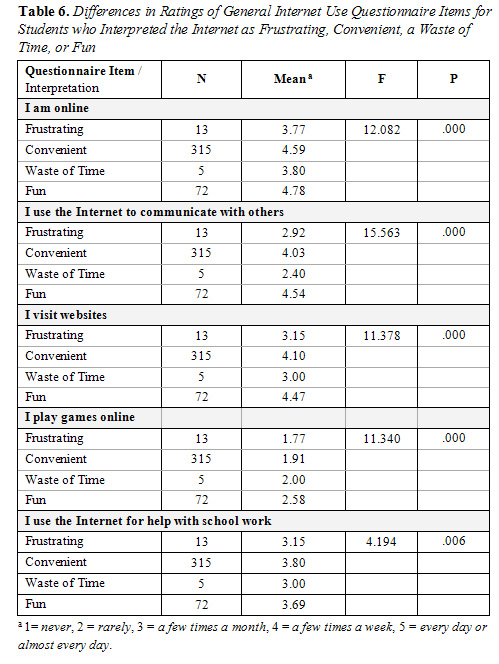
Relative to the general population (Statistics Canada, 2006), Canadian college students are more likely to use the Internet. Results of the current investigation depict Canadian college students, with rare exception, as Internet users. It is difficult, but not impossible, to locate a college student who has not used the Internet. The vast majority of college students frequently use the Internet to communicate and access websites. While an Internet game experience is typical, relatively few college students are heavy online gamers.
Online educators can reasonably assume that most college students expect e-learning to be convenient, although a significant proportion may expect such learning to be fun. While web-based education is virtually synonymous with convenience (i.e., unrestricted by time, place, and pace; Johnson, in press-b), online instruction requires increased attention to student perception of learning as fun (particularly for students in late adolescence and early adulthood). Indeed, high levels of peer interaction reportedly facilitate college student satisfaction with online study groups (Johnson, in press-c) and interactive games have been associated with mastery of course content in higher education (Smith-Stoner & Willer, 2005). With respect to workplace e-learning, Flood (2006) noted that “games-based learning combines graphics, gameplay and training technologies to create a compelling training experience” (¶ 8).
Results of the current investigation suggest that almost 5% of college students have a negative interpretation of the Internet. That is, college students who rated the Internet as a source of frustration (3.2%) may be struggling with specific Internet skills (O'Hanlon, 2002); students who reported the perception that the Internet was a waste of time (1.2%) may defend lack of Internet competencies via ego-sustaining attributions (Bessier, Newhagen, Robinson, & Shneiderman, 2006). Online educators may legitimately assume that one in 20 college students would benefit from Internet skills training and/or instructional strategies that enhance effective utilization of e-learning opportunities.
As is the case with all human behaviour, college student use of the Internet reflects specific contextual opportunities and constraints. For example, the online dating rate for the current sample of college students was equivalent to estimates in the general population (Grabianowski, 2006). In the college context, where potential romantic partners abound, online dating rates may suggest increasing endorsement of such interpersonal interaction. Additionally, instant messaging is far more common among the sample of college students (34.7% every day or almost every day) than among the general population (Fox & Madden, 2006). Developing a pool of individuals to instant message is facilitated by the college context (e.g., group work, instructional applications of Internet technology, and institutional assignment of e-mail addresses to all students). But as Díaz-Canepa (2005) argued, the context “determines the way a tool is used and the functional value it assumes.” The context “actually determines how a tool’s characteristics – its complexity, affordability, functional rhythm, capacity, and flexibility – affect people’s lives” (p. 166). Thus, while “studying college students’ Internet habits can yield insight into future online trends” (Jones & Madden, 2002, p. 5), specific patterns of Internet use may not generalize across contexts.
The current investigation included students from one college in western Canada. Such a sample limits generalization of findings. Future studies with more comprehensive samples may reveal various patterns of Internet use in different parts of the country, within differing institutional contexts (e.g., college vs. university vs. technical institutions), and for students with varying career aspirations (e.g., education vs. science students). Furthermore, the current sample distribution of males and females does not reflect the general population. A sample described as 72% female has obvious limitations that should be addressed with more rigorous sampling procedures.
To date, Internet use has been consistently and exclusively determined via self-report questionnaire or interview (Nie et al, 2005; Statisitcs Canada, 2006; U.S. Census Bureau, 2005), as was the case in the current investigation. Such an approach is vulnerable to biased responding ( McNeill & Chapman, 2005). Biased responding includes both conscience and unconscious distortions; respondents under-report or over-report behaviours based on personal values and beliefs. For example, self-report questionnaire data may reflect college student believe that certain types of Internet use are valued (e.g., I use the Internet for help with school work) while others are devalued (e.g., I play games online). Simple solutions such as the development of software and firmware to monitor students’ online behaviour may provide misinformation. That is, surveillance influences behaviour (Rosnow & Rosenthal, 1997), college students access the Internet from multiple locations (Table 2), and adolescent Internet use reportedly involves multiple users (Roberts, Foehr, & Rideout, 2005). Improved approaches to measuring Internet use are required.
Given the rate of population penetration (Internet World Stats, 2006) coupled with rapidly changing technology (Tuomi, 2006), college student Internet use and patterns of online behaviour require continual monitoring. The Pew Internet and American Life Project (2006), “an authoritative source on the evolution of the Internet through collection of data and analysis of real-world developments as they affect the virtual world” (p. 1), generates comprehensive information on college student use of the Internet. A corresponding Canadian authority is not easily identified. Sound instructional practice situates curriculum in relation to learner characteristics, generally, and background competencies, specifically (Johnson, 1998). Sound online instruction is hardly an exception (Johnson & Johnson, 2006). Patterns of online behaviour reflect Internet attitudes and competencies, information critical to effective web-based instruction.
Anderson, N. (2006). Internet replaces Jack Daniel's as "best excuse for a C average." ARS Technica. Available at http://arstechnica.com/news.ars/post/20060920-7791.html
Arnett, J. J. (2004). Emerging adulthood: The winding road from the late teens through the twenties. New York: Oxford University Press.
Bessier, K, Newhagen, J. E., Robinson, J. P., & Shneiderman, B. (2006). A model for computer frustration: The role of instrumental and dispositional factors on incident, session, and post-session frustration and mood. Computers in Human Behavior, 22, 941–951.
Chou, C. (2003). Incidences and correlates of Internet anxiety among high school teachers in Taiwan. Computers in Human Behavior, 19, 731–749.
Díaz-Canepa, C. (2005). Transferring technologies to developing countries: A cognitive and cultural approach. In R. J. Sternberg & D. D. Preiss (Eds.), Intelligence and technology: The impact of tools on the nature and development of human abilities (pp. 159–179). Mahwah, NJ: Lawrence Erlbaum.
Finn, J. (2004). A survey of online harassment at a university campus. Journal of Interpersonal Violence, 19, 468–483.
Flood, S. (2006, March). All play and more work. Computing, 23. Available at http://www.vnunet.com/computing/analysis/2152597/play-work
Fox, S. (2002). Online Banking 2002. Washington, DC: Pew Internet and American Life Project. Available at http://www.pewinternet.org/PPF/r/77/report_display.asp
Fox, S., & Madden, M. (2006). Generations online. Washington, DC: Pew Internet and American Life Project. Available at http://www.pewinternet.org/PPF/r/170/report_display.asp
Geist, C. (1997). Introduction. Videotopia. Available at http://www.videotopia.com/intro.htm
Grabianowski, E. (2006). Online dating statistics. Available at http://people.howstuffworks.com/online-dating7.htm
Internet World Stats. (2006). Usage and population statistics. Available at http://www.internetworldstats.com/am/ca.htm
Joepen, H. (2005). Instant messaging. ITNOW, 47, 26.
Johnson, G. M. (1998). Principles of instruction for at-risk learners. Preventing School Failure, 42, 167–174.
Johnson, G. (2006a). A theoretical framework for organizing the effect of the Internet on cognitive development. Proceedings of World Conference on Educational Multimedia, Hypermedia and Telecommunications 2006 (pp. 3041–3048). Norfolk, VA: AACE.
Johnson, G. M. (2006b). Synchronous and asynchronous text-based CMC in educational contexts: A review of recent research. TechTrends, 50, 46–53.
Johnson, G. M. (in press-a). Internet use and cognitive development: A theoretical framework. E-Learning.
Johnson, G. M. (in press-b). Restricted versus unrestricted learning: Synthesis of recent meta-analyses. AACE Journal.
Johnson, G. M. (in press-c). Online study groups: Reciprocal peer questioning vs. mnemonic devices. Journal of Educational Computing Research.
Johnson, G. M., & Howell, A. J. (2005). Attitude toward instructional technology following required vs. optional WebCT usage. Journal of Technology and Teacher Education, 13, 643–654.
Johnson, G. M., Howell, A. J., & Code, J. R. (2005). Online discussion and college student learning: Toward a model of influence. Technology, Pedagogy and Education, 14, 61–76.
Johnson, G. M., & Johnson, J. A. (2006). Personality, Internet experience, and e-communication preference. In P. Isaias, M. B. Nunes, & I. J. Martinez (Eds.), Proceedings of the IADIS International Conference WWW/Internet 2006, Vol. 1 (pp. 55–62). Murcia, Spain: IADIS Press.
Joiner, R., Gavin, J., Duffield, J., et al. (2005). Gender, Internet identification, and Internet anxiety: Correlates of Internet use. Cyber Psychology & Behavior, 8, 371–378.
Jolliffe, I. T. (2002). Principal component analysis. New York: Springer-Verlag.
Jones, S. (2003). Let the games begin: Gaming technology and entertainment among college students. Washington, DC: Pew Internet and American Life Project. Available at http://www.pewinternet.org/PPF/r/93/report_display.asp
Jones, S., & Madden, M. (2002). The Internet goes to college: How students are living in the future with today’s technology. Washington, DC: Pew Internet and American Life Project. Available at http://www.pewinternet.org/PPF/r/71/report_display.asp
MacGowan, S. (2004). The ultimate online dating guide. Victoria, BC: Trafford Publishing.
Madden, M., & Rainie, L. (2005). Music and video downloading moves beyond P2P. Washington, DC: Pew Internet and American Life Project. Available at http://www.pewinternet.org/PPF/r/153/report_display.asp
Marriott, N., Marriott, P., & Selwyn, N. (2004). Accounting undergraduates' changing use of ICT and their views on using the Internet in higher education. Accounting Education: An International Journal, 13, 117–130.
McNeill, P., & Chapman, S. (2005). Research methods. New York: Routledge.
Nie, N. H., & Erbring, L. (2002). Internet and society: A preliminary report. Information Technology and Society, 1, 275–283.
Nie, N. H., Simpser, A., Stepanikova, I., & Zheng, L. (2005). Ten years after the birth of the Internet, how do Americans use the Internet in their daily lives? Stanford, CA: Stanford Institution for the Quantitative Study of Society.
Nunnaly, J. (1978). Psychometric theory. New York: McGraw-Hill.
O'Hanlon, N. (2002). Net knowledge: Performance of new college students on an Internet skills proficiency test. The Internet and Higher Education, 5, 55–66.
Pew Internet and American Life Project. (2006). Our mission. Washington, DC: Available at http://www.pewinternet.org/about_mission.asp
Roberts, D. F., Foehr, U. G., & Rideout, V. (2005). Generation M: Media in the lives of 8 – 18 year olds. Menlo Park, CA: The Henry J. Kaiser Family Foundation.
Rodriquez, M. C., Ooms, A., Montanez, M., & Yan, Y. L. (2005). Perceptions of online learning quality given comfort with technology, motivation to learn technology skills, satisfaction, and online learning experience. Paper presented at the Annual Meeting of the American Educational Research Association. Montreal, QC. (ERIC Document Reproduction Service No. ED491688).
Rosnow, R. L., & Rosenthal. R. (1997). People studying people: Artifacts and ethics in behavioral research. New York: W. H. Freeman.
Seyal, A. H., Rahman, M. N., & Rahim, M. M. (2002). Determinants of academic use of the Internet: A structural equation model. Behavior and Information Technology, 21, 71–96.
Sharpe, R. & Greg, B. (2005). The student experience of e-learning in higher education: A review of the literature. Brookes e Journal of Learning and Teaching, 1 . Available at http://www.brookes.ac.uk/publications/bejlt/volume1issue3/academic/sharpe_benfield.html
Shih, Y. Y., & Fang, K. (2004). The use of a decomposed theory of planned behavior to study Internet banking in Taiwan. Internet Research, 14, 213–223.
Silver, C. (2001). Older surfers. Canadian Social Trends, 63, 9–12.
Smith-Stoner, M., & Willer, A. (2005). Innovative use of the Internet and intranets to provide education by adding games. CIN: Computers, Informatics, Nursing, 23, 237–241.
Statistics Canada (2006). Canadian Internet use survey 2005. Available at http://www.statcan.ca/Daily/English/060815/d060815b.htm
Tuomi, I. (2006). Networks of innovation: Change and meaning in the age of the Internet. New York: Oxford University Press.
UCLA World Internet Project. (2004). First release of findings from the UCLA World Internet Project shows significant ‘Digital Gender Gap’ in many countries. UCLA News. Los Angeles, CA. Available at http://newsroom.ucla.edu/page.asp?RelNum=4849
U.S. Census Bureau (2005). Computer and Internet use in the United States: 2003. Washington, DC. Available at http://www.census.gov/prod/2005pubs/p23-208.pdf
Zhang, Y. (2002). Comparison of Internet attitudes between industrial employees and college students. CyberPsychology & Behavior, 5, 143–149.
© Canadian Journal of Learning and Technology